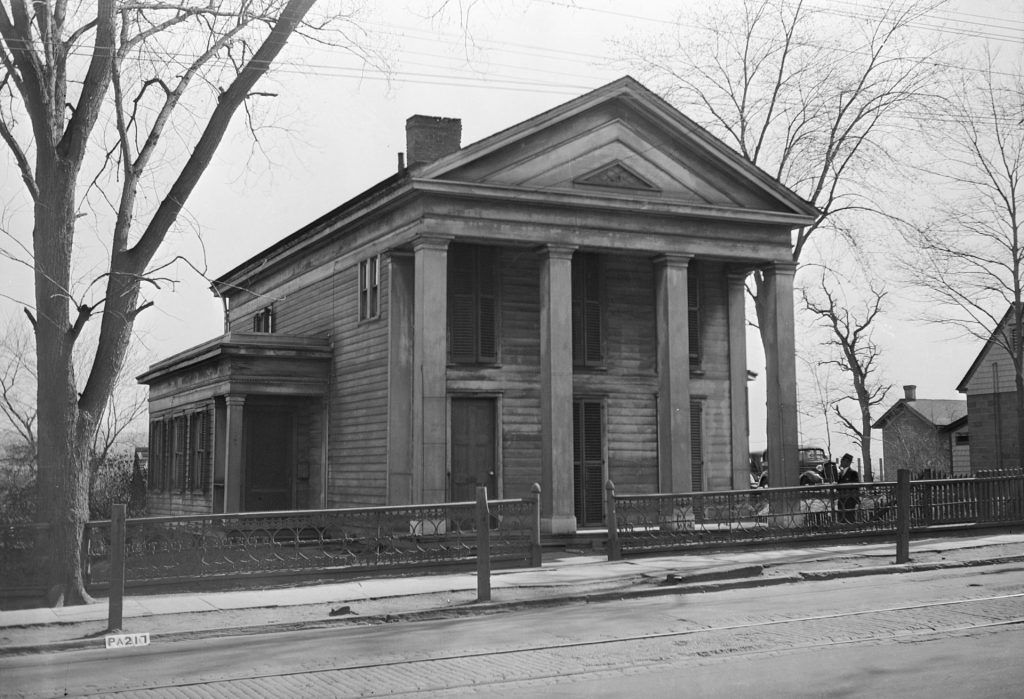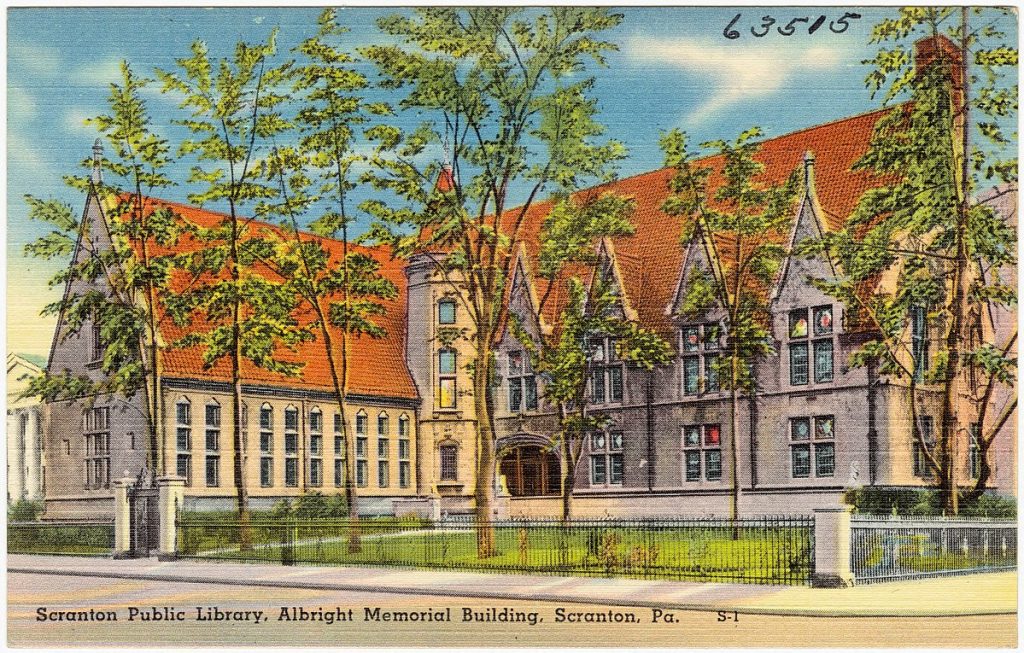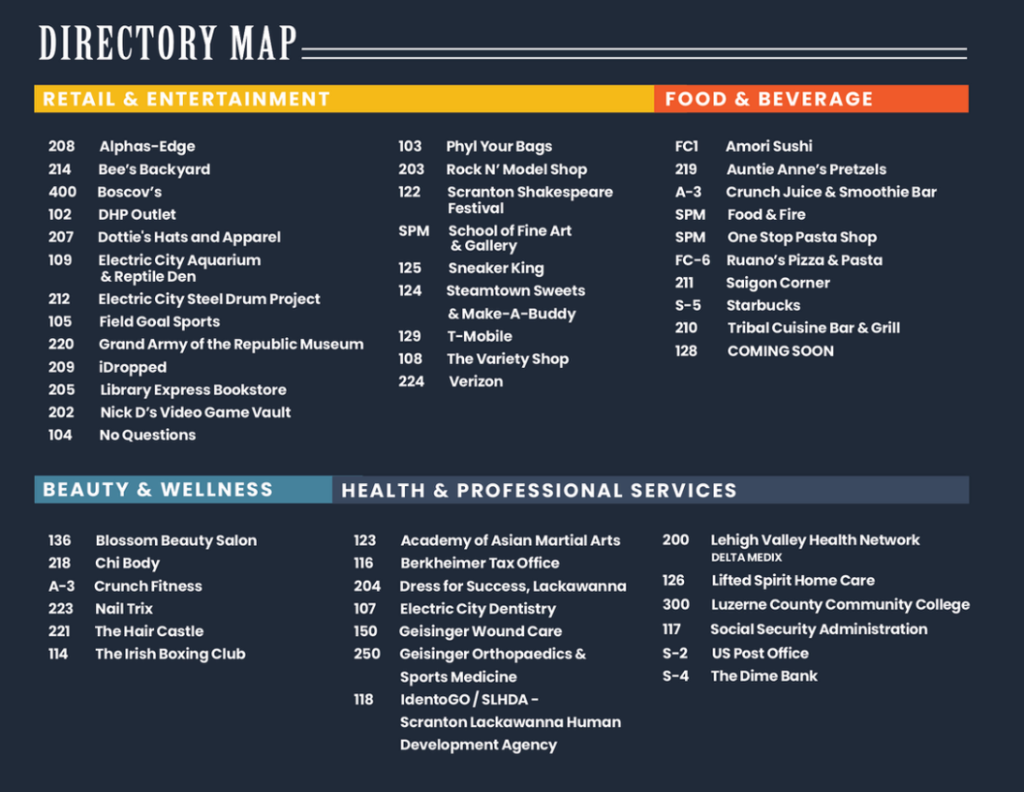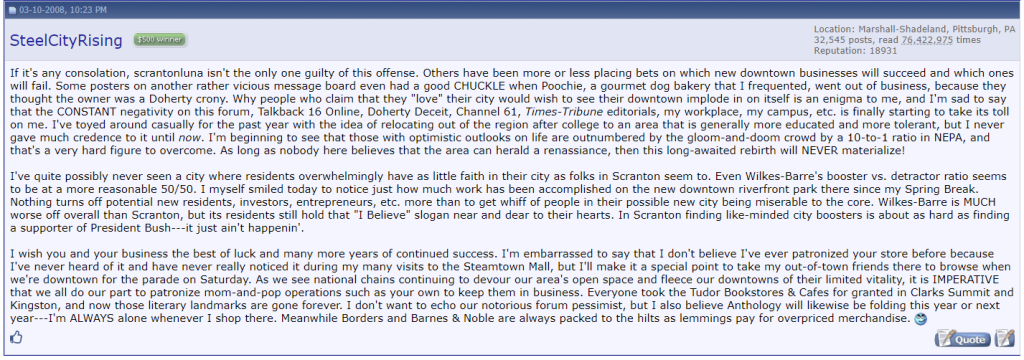Library Express – Searching for stability as the Electric City flickers
“Bookstores come and bookstores go, but perhaps the library is forever.”
It’s an eye-catching quote, isn’t it? For that reason, I don’t feel too bad for making it up. It’s not exactly what Carrión said when discussing the two, but it might as well have been. In chapter 2 of “Bookshops: A Reader’s History”, Carrión characterizes the libraries as endpoint collections for literature, propped up and sanctioned by their connections to authority (Carrión, p. 41). Bookstores, on the other hand, are much more mercurial and nebulous: they exist to sell their wares for a short time, and then disappear into the annals of history, forgotten as institutions, while historians wax over the lost and found libraries of old in their modern libraries. One might even infer some sort of libertarian ideology here – the idea that the library and all its authority stands in opposition to the poor little bookstore, overshadowing it and sucking wares from it until the latter dries up. If that’s what is said about the two individually, one must then naturally wonder what could be said about Scranton’s Library Express as the child and thus inheritor of the two conflicting approaches to text acquisition.
Though it might be one of the lone bookstores in Scranton, the Library Express does not stand alone. The Library Express is a part of the larger Lackawanna County Library System, and thus shares its history in that. The Library’s proprietor has its public-facing offices about four blocks away, down at the Scranton Children’s Library and its private offices down at the Silkman House. Both are housed in historical buildings, purchased and subsequently refurbished by the Scranton Public Library board: the latter was home to the Christian Science Church and the other one of the oldest buildings in Scranton.

However, while the history of these two buildings and how they came to be acquired as government property from private enterprises is interesting, their previous proprietors are certainly not as indicative of Scranton’s history as the Albright Library’s is.

The Albright Library is the keystone library of the Electric City and its historical first, located just next to the Children’s Library, meaning only four blocks down from the Steamtown Mall. The Albright building, as one could gather from the name, was originally the home of the Albrights, a multigenerational family of coal, iron/steel, railroad and bank magnates throughout the late 1800’s. While the age might have been known as the “Gilded Age”, the splendor was quickly chipped away to reveal the rusty, sooty history underneath the surface: soon after the Albright family donated the library, they moved their industry out of the city, leaving many of the workers unemployed. Though in the eyes of the capitalists it might have just been a move of economic passion (westward was, quite literally, gold, and oil, too!), this betrayal must have been viewed as an act of retribution by the workers: in the years just prior to the Albright’s leaving, the Scranton coal workers went on the biggest coal strike that Luzerne and Lackawanna counties had ever seen. Terence V. Powderley, former mayor of the Electric City, was soon ejected from the largest union in America, the equally famous and infamous Knights of Labor. Without any leadership from unionist or industrialist, their city was left to decompose, the only memory of capitalist goodwill being the library, and nothing else left to fill the hole that the mining industry left but resentment.
It was in these years of the growing Rust Belt, as the businesses that abandoned Scranton soon came to abandon American workers entirely, that the library gradually expanded itself throughout the city, buying old landmarks that once belonged to the richest families of Scranton, and refurbishing them into wings of its organization.
As I discussed in my last post, that economic rut and rot that characterizes the Rust Belt has still not alleviated in Scranton, despite the good intentions of many such businessmen to add a new color of paint. The mall itself in which the Marketplace @ Steamtown is held started out that way – an economic venture to hopefully garner community spirit and a new jolt of life for the Electric City’s circuit – as did the Museum out back.
Has it been working? Well, it doesn’t seem like it, though there’s no real data to quantify if it has or hasn’t been.
I tried to find data on the stores that opened and closed in Scranton, but unfortunately such information is not gathered and treated like the government census and instead falls into the opportune laps of market research firms. Any information that would have been compiled is then locked behind pretty steep paywalls and services that would take a whole new academic program for me to become acquainted with. In some ways, it’s almost a mini library versus bookstore dichotomy.


What I was able to find, in plentiful amount, was complaints about the dying city and its similarly struggling economy. Most humorous to me were pictures from just one year ago, from the subreddit “Dead Malls”, dedicated to the cataloguing of the dead mall late-stage-capitalist phenomenon.
The Marketplace At Steamtown, Scranton, PA.
byu/VisualDimension292 indeadmalls
More interesting, though, was an old forum on “city-data.com” in 2008, where users discussed recent business closures in the city. However, like many classic forums do, it eventually derailed into political arguments about the intentions of mayors, with business owners even chiming into remind readers that the rumors of their stores’ deaths were greatly exaggerated: much like Rust Belt industries, the petit bourgeoisie had simply moved shop elsewhere.
Most interesting of all to me was the information that a Barnes & Nobles had, in fact, once called the Marketplace @ Steamtown home, much like Library Express does now. Interestingly, this means that some of these forum user’s prayers were answered in a roundabout way. While Anthology books mysteriously closed without a trace back in 2011, a bookstore did return to the mall a year later: the Library Express.
However, as the forum users explain, niche markets are an issue for businesses in Scranton. Books are apparently niche enough to drive two dedicated bookstores away from the city’s disinterested customers less than five years before the Library Express opened.
So, why did the Library Express open up in a dying Rust Belt city where the last bookstore so quickly closed up shop before it and the people are so virulently opposed to small businesses out of economic necessity? Clearly, the Library did not do so out of profit: if that was the case, a dead mall with minimal foot traffic is a terrible move, especially when the Library can and already has bought and refurbishing real-estate instead of renting it before. It was not done for accessibility, or for passion, or for learning, as all of these are redundant when the Lackawanna County Library System already has so many nodes spread out throughout the city.
It must be out of ideology, then, akin to Una Mulzac’s Liberation Bookstore and other bookstores like it (Davis 38). Unlike those bookstores, though, the Library Express is not just a place of learning or programming. While it certainly is and does function as that, it is redundant with the library in this way. Its place in promoting the small-business open-night “First Friday” trend across the state is quite telling. Library Express exists to fulfill an economical niche within the community’s ecosystem: it is the quintessential library bookstore that must exist to ensure a well-read populace, as Archibald MacLeish might say.
It might not be in Scranton’s interest to remain capitalist, nor might it be in the library’s best interest to run a bookstore in the mall. Small businesses dry up as the citizens routinely prefer the convenience and assortments of larger stores. However, when large corporations have such a history of mistreating and abandoning you as they do in Scranton, perhaps it is only right that your city government steps in to shoulder the economic burden, just as the Library Express is doing now in Scranton. While the laborers who worked and striked for the good of the people of Scranton years ago have passed, their electric spirit will live on.
Works Cited
Class Content
Carrión, Jorge. Bookshops: A Reader’s History, translated by Peter Bush. Biblioasis, n.d..
Davis, Joshua Clark. From Head Shops to Whole Foods: The Rise and Fall of Activist Entrepreneurs. New York City, Columbia University Press, n.d..
Macleish, Archibald. “A Free Man’s Books”. Mount Vernon, The Peter Pauper Press, n.d..
Media
“Eyewitness to History: Steamtown Mall Opens.” YouTube, YouTube, 4 Oct. 2019, https://www.youtube.com/watch?v=ZaKz7Eoche8. Accessed 8 Oct. 2023.
Jones, Stanley. Silkman House, Scranton. 26 April 1936, Library of Congress, Prints & Photographs Division, PA,35-SCRAN,1-2, https://commons.wikimedia.org/wiki/File:Silkman_House,_Scranton.jpg. Accessed 8 Oct. 2023.
Mebane, R. Ramsey. Scranton Public Library, Albright Memorial Building, Scranton, Pa.. Boston Public Library Tichnors collection, https://commons.wikimedia.org/wiki/File:Scranton_Public_Library,Albright_Memorial_Building,_Scranton,_Pa(63515).jpg. Accessed 8 Oct 2023.
The Times Tribune. “Invitations to the Opening.” Newspapers by Ancestry, https://www.newspapers.com/article/75815117/the-times-tribune/. Accessed 8 Oct. 2023.
VisualDimension292. “The Marketplace At Steamtown, Scranton, PA.” Reddit, 26 July 2022, https://www.reddit.com/r/deadmalls/comments/w8x3d3/the_marketplace_at_steamtown_scranton_pa/. Accessed 8 Oct. 2023.
weluvpa, NYRangers 2008, SteelCityRising, et al. “3 Business’s closed in Downtown Scranton and soon to be 4 (Wilkes-Barre: to rent, condo).” City-Data.com, 5 January 2008, https://www.city-data.com/forum/northeastern-pennsylvania/226476-3-businesss-closed-downtown-scranton-soon.html. Accessed 8 Oct. 2023.
Research
Domitrovic, Brian. “The Origin of the Rust Belt – Part 1.” Forbes, 9 Oct 2022, https://www.forbes.com/sites/briandomitrovic/2022/10/09/the-origin-of-the-rust-belt–part-1/?sh=5552712d104f. Accessed 8 Oct 2023.
ExplorePAhistory.com. “Terence V. Powderley Historical Marker.” https://explorepahistory.com/hmarker.php?markerId=1-A-3BE. Accessed 8 Oct 2023.
Falchek, David. “Mall at Steamtown looks to recreate image.” The Times-Tribune, 24 June 2020, https://www.thetimes-tribune.com/news/mall-at-steamtown-looks-to-recreate-image/article_42af6213-fc05-5506-ad23-d9b293710416.html. Accessed 8 Oct 2023.
Lackawanna County Library System. https://lclshome.org/. Accessed 8 Oct 2023.
Lackawanna Historical Society. “The Silkman Houses and the Silkmans”. The Lackawanna Historical Society Bulletin, 5(5), May-June 1971.
LaChiusa, Chuck. “Lackawanna Steel Company and Buffalo and Susquehanna Iron Company”. History of Buffalo, https://buffaloah.com/h/lacksteel/index.html. Accessed 8 2023.
Lange, Stacy. “Labor Day’s rich history in Scranton.” WNEP16, 6 September 2021, https://www.wnep.com/article/news/local/lackawanna-county/labor-days-rich-history-in-scranton-courthouse-square/523-19c35c1b-5368-4831-92ed-29f7a26ad0e4. Accessed 8 Oct 2023.
Lockwood, Jim. “Scranton Public Library opens book on strengths, weaknesses to plan improvements.” The Times-Tribune, 19 January 2021, https://www.thetimes-tribune.com/news/scranton-public-library-opens-book-on-strengths-weaknesses-to-plan-improvements/article_296d2968-f818-548a-bd5a-0ee5f422338b.html. Accessed 8 Oct 2023.
Lockwood, Jim. “Scranton Public Library takes community pulse.” The Times-Tribune, 6 July 2020, https://www.thetimes-tribune.com/news/scranton-public-library-surveys-community-on-next-chapter/article_df861692-bcb6-57be-9483-d6e5d0bb16f2.html. Accessed 8 Oct 2023.
Malls and Retail Wiki. “The Marketplace at Steamtown”, Fandom, https://malls.fandom.com/wiki/The_Marketplace_at_Steamtown. Accessed 8 Oct 2023.
Palumno, Andy. “Welcome to The Marketplace At Steamtown.” WNEP16, 31 May 2016, https://www.city-data.com/forum/northeastern-pennsylvania/226476-3-businesss-closed-downtown-scranton-soon.html.
Pennsylvania Labor History Society. “Timeline of Labor History in Pennsylvania.” https://palaborhistorysociety.org/timeline-of-labor-history-in-pennsylvania/. Accessed 8 Oct 2023.
PowerLibrary. “Scranton Public Library – History of the Scranton Public Library.” https://digitalarchives.powerlibrary.org/papd/islandora/object/papd%3Apscrl-hspl. Accessed 8 Oct 2023.
The Times Tribune. “Library Ownership of Church Site Official.” Newspapers by Ancestry, https://www.newspapers.com/image/639879435/?clipping_id=77917182&fcfToken=eyJhbGciOiJIUzI1NiIsInR5cCI6IkpXVCJ9.eyJmcmVlLXZpZXctaWQiOjYzOTg3OTQzNSwiaWF0IjoxNjk2Nzk1NDkwLCJleHAiOjE2OTY4ODE4OTB9.SnomedkhUTiaeFgwu9BsG3cPaUiZTudTp4H1k76AnlU. Accessed 8 Oct 2023.
The Times Tribune. “Silkman House Branch Library Opens Tonight.” Newspapers by Ancestry, https://www.newspapers.com/article/77980305/the-times-tribune/. Accessed 8 Oct 2023.






I realized while I was writing the citations that I wrote Powderly’s name wrong in literally every iteration I typed it, and that all of my newspapers were cited incorrectly. At least I remained consistent!